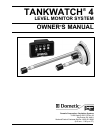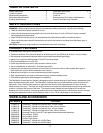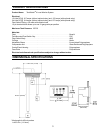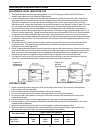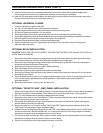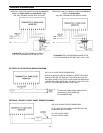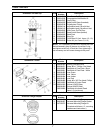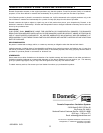
5
INSTALLATION INSTRUCTIONS
9. Insert the correct color lens in the appropriate hole from the front side of the face plate, snapping the
matching light into the lens firmly. Repeat with the three (3) remaining lens and lights.
10. Insert the (2) small tabs on the left side of the face plate into the housing and snap the large center tab on
the right of the face plate into the housing to secure it.
OPTIONAL UNIVERSAL FLANGE
1. Find and mark the top center of the tank.
2. Cut a 4 1/16-inch diameter hole in the top center of the tank.
3. Slip the flange into the hole and mark the location of the five mounting holes.
4. Drill the five mounting holes with a 1/4-inch drill bit.
5. Remove the flange, clean all oils, grease and dirt from the mounting surface and allow to dry.
6. Apply liberal amounts of silicone rubber adhesive to the mounting surface and the underside of the flange.
7. Insert the gasket into the flange and align with the five mounting holes.
8. Secure the flange with the screws, nuts and washers provided.
9. Install the float switch cap and, if applicable, secure the 5/8-inch vent hose to the vent fitting with a
stainless steel hose clamp.
OPTIONAL RELAY INSTALLATION
CAUTION: VERIFY THAT RELAY IS CORRECT VOLTAGE FOR SYSTEM (12VDC requires P/N 341292 and
24VDC requires P/N 342490).
1. Remove the face plate from the housing by prying the right side center tab of face plate from the housing
with a small screwdriver. Allow the face plate to be suspended by the light wires.
2. Remove the four housing mounting screws and pull the housing out of the wall or hull liner, exposing the
wiring terminal block at the rear of the housing.
3. Mark the wires for terminal block pin location before removing.
4. Remove all wires from the terminal block.
5. Remove the (2) screws securing the circuit board to the housing.
6. Slide the circuit board from the housing and insert the relay into the socket on the rear of the circuit board.
7. Reinstall the circuit board.
8. Route the additional wires (use 12 or 14 gauge stranded copper) to pin 10 and 11 to interrupt power for the
toilet or water system, depending on the tank application. (See optional relay wiring diagram for
application details.)
9. Reinstall all other wires. Turn on power and test circuit.
OPTIONAL “DO NOT FLUSH” (DNF) PANEL INSTALLATION
1. Select a mounting location in the bathroom away from direct contact with water. A location above and behind
the toilet at eye level is most desirable. Allow clearance for the toilet lid/seat when in the up position.
2. Drill a 1/2-inch diameter hole for the lamp clearance and wire routing.
3. Remove the face plate from the TankWatch 4 (TW4) housing by prying the right side of the face plate center
tab from the housing using a small screw driver.
4. Remove the four housing mounting screws and pull the housing out of the wall of hull liner exposing the
terminal block on the rear of the housing.
5. Route wires from pins 1 or 2 and pin 8 of the TW4 to the “DNF” panel through the clearance hole for the
“DNF” panel. (Use 18 gauge or larger stranded copper.)
6. Install the current limiting resistor supplied with the “DNF” panel between the white wire on the “DNF” panel
and the wire from the TW4 terminal block pin 1 or 2 (see optional Do Not Flush wiring diagram for details).
Insulate the connection with vinyl electrical tape or shrink tubing.
7. Connect the orange wire from the “DNF” panel to the wire from pin 8 of the terminal block on the TW4 panel.
Insulate the connection with vinyl electrical tape or shrink tubing.
8. Test the circuit and then mount both panels to the wall or hull liner.
(con’t.)



